NYC’s Forgotten ‘War on Christmas Trees’
Discover how an obscure holiday crackdown affects festive street vendors today!


It’s almost a certainty that if you ask anyone around the world with even the slightest knowledge of pop culture, they will have at least heard of Madison Square Garden. The venue is not only one of New York City’s most famous attractions but also billed as “the world’s most famous arena.” Referred to simply as the Garden, the venue has held everything from sports games and circuses, to concerts and stand-up comedians. The Garden is the spot where aspiring entertainers dream of performing. But while the arena might be one of the world’s most recognizable, it holds its fair share of secrets that very few people know about.
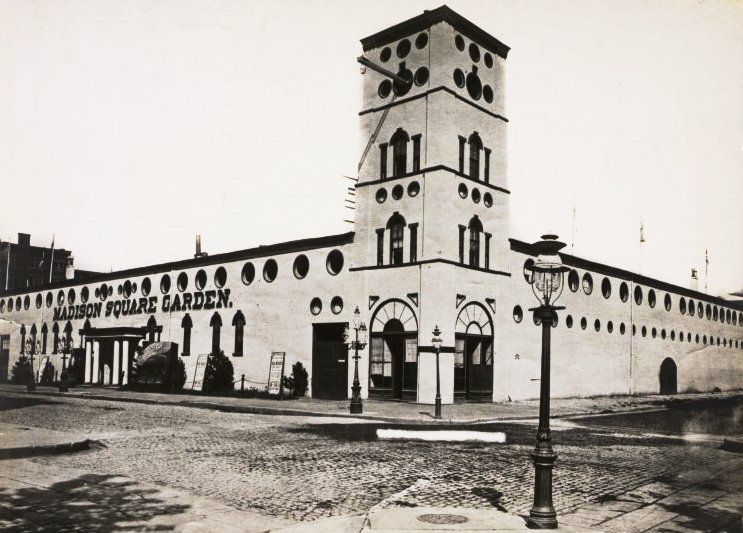
More likely than not, when someone mentions Madison Square Garden, they are referring to the current building at 4 Pennsylvania Plaza in Midtown Manhattan, but most don’t realize that the current building is actually the fourth iteration to don the name. The first Madison Square Garden was built in 1879 just north of Madison Square Park. The building sat 10,000 spectators and was used frequently for circuses until it was demolished in 1890 because the venue had no roof, making it difficult to hold events in inclement weather.
The first iteration of Madison Square Garden was replaced by a new arena in the same location in 1890. The new venue, though, was rocked by a scandal when the building’s architect, Stanford White, was murdered in the building by Henry Kendall Thaw for his affair with Thaw’s wife, prominent actress Evelyn Nesbit. A third Madison Square Garden was built in 1925, the first to be constructed at a different location. It held over 18,000 people and was built by boxing promoter Tex Rickard, who used the building frequently for fights. The building was demolished from 1968 to 1969, when the current Madison Square Garden was opened.
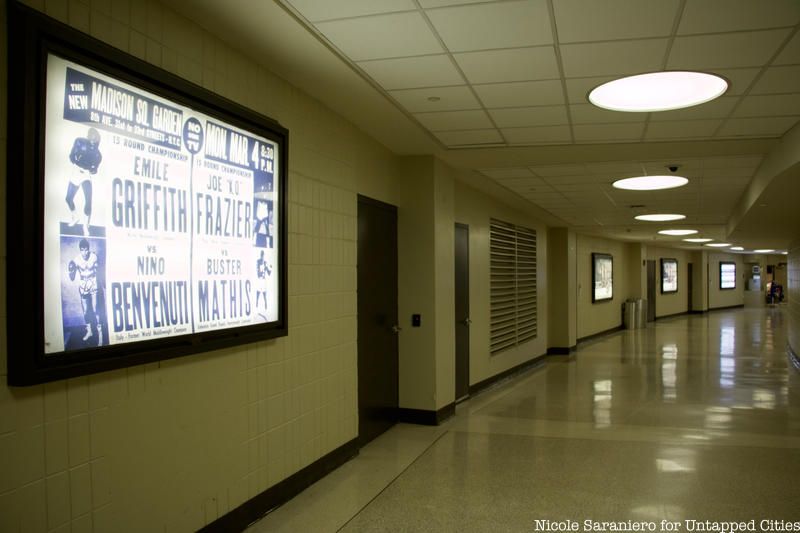
For three summers starting in 2011, Madison Square Garden underwent a massive transformation. The $1 billion renovation included the addition of the bridge level that runs high above the event floor, a remodeled 7th Avenue entrance, a state-of-the-art scoreboard, new suites and food options, and other upgrades. Basically, everything in the building was given a facelift. There are, however, some spots where you can see the vintage past, including the 1968 South Corridor.
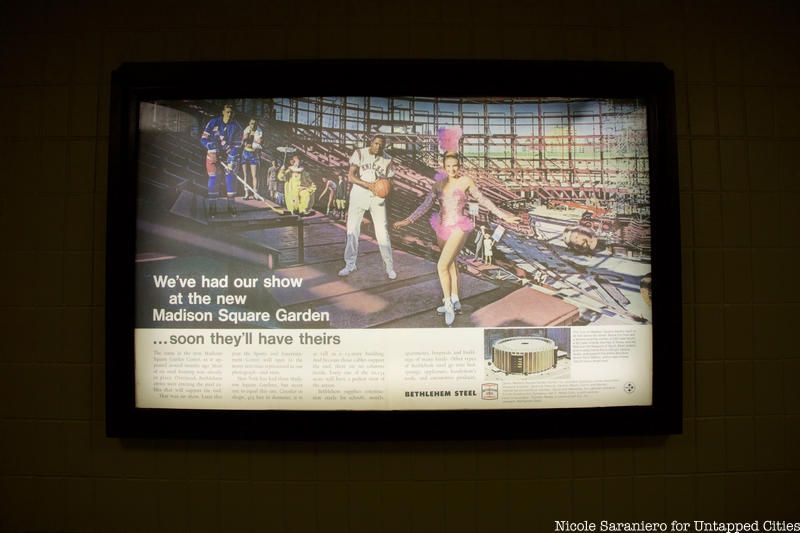
The corridor is so named because the walls, floors and lighting are all how they would have appeared in 1968. Vintage ads from the period for events at the arena line the corridor. The entry-level passageways are usually closed and used only by employees, but visitors do use the hallways to empty out from an event, so the next time you are leaving a concert or game, be sure to look around. Another nod to the 1968 Garden is the Blue Seats section in the upper balcony of the arena behind the Rangers goal; the light blue of this section matches the color all of the seats once were in 1968.
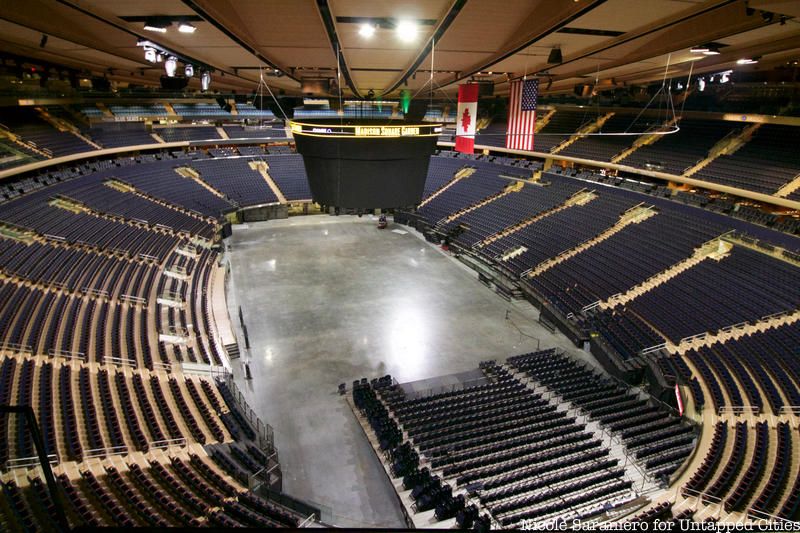
Due to Madison Square Garden’s busy schedule, the venue often has multiple shows or events on the same day, making efficiency key to running a smooth operation. This is especially the case in the winter, when both the New York Knicks and New York Rangers call the arena home.
To make the quick transition from ice to floor, or vice versa, the ice is kept underneath the basketball court, or stage, and covered with an insulated top to keep it cool. When the venue calls for ice, staff just remove the court or stage and the insulation to reveal the underlying floor of ice. The crew sprays thin layers of water on the 17,000-square-foot surface of the rink, which is chilled by pipes in the concrete, to create the ice. They also hand paint the blue zone lines and red face-off circles. The transition from ice to court usually takes just two hours.
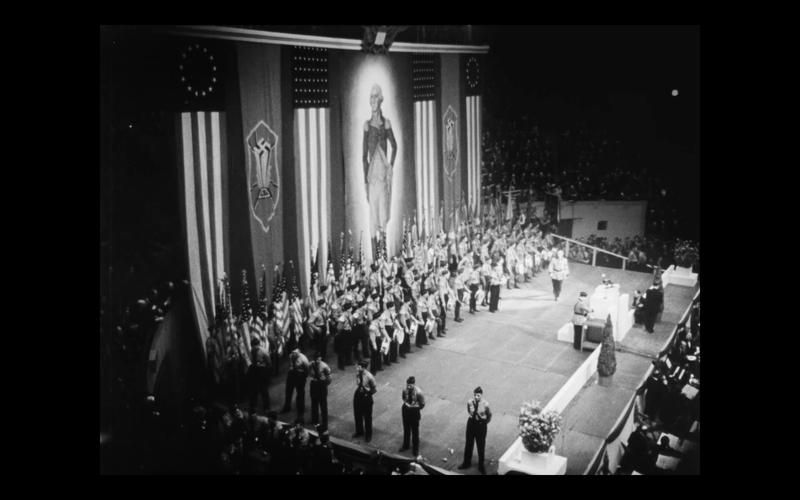
Screenshot of historical footage from Michael Curry’s short documentary Night at the Garden
The Garden has hosted many positive and historic events such as the 12-12-12 benefit concert for Hurricane Sandy and George Harrison’s Concert for Bangladesh. However, there are some dark spots in its repertoire. In 1939, inside the third iteration of Madison Square Garden on 8th Avenue between 49th and 50th Streets, there was a Nazi rally hosted by the German American Bund. The rally was the subject of a short documentary by filmmaker Marshall Curry, which featured historic footage from inside.
Twenty thousand Nazi supporters filled the arena to hear from German American Bund leader Fritz Julius Kuhn as he stood in front of a giant portrait of George Washington. The German American Bund was founded in 1936 by pro-Nazi ethnic Germans living in the United States. The organization ran several summer camps for Nazi youth throughout the United States and Camp Siegfried, a pro-Nazi planned community in Yaphank, Long Island, with streets named after Hitler, Goering, and Goebbels. New Yorkers who opposed the rally protested outside and held a counter rally at Carnegie Hall. The Nazi rally was an anomaly in the usual programming since throughout the 1930s, Madison Square Garden hosted many anti-Nazi rallies attended by public officials and religious leaders.
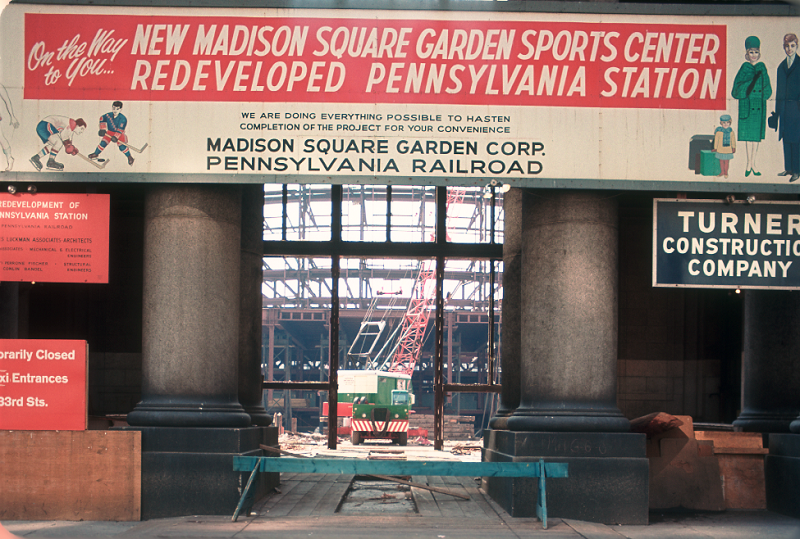
Facade of original Penn Station with Madison Square Garden construction peaking under the sing. Image by Norman McGrath.
The current arena to be called Madison Square Garden was constructed in 1968 between 7th and 8th Avenue. Because the stadium was built on top of the busiest transit hub in the country, Penn Station needed to be demolished and reconfigured. The demolition of the original Penn Station led to the formation of the New York City Landmark Preservation Commission after disapproval from many members of the public.
The original Pennsylvania Station was constructed between 1904 and 1910, designed by McKim, Mead, and White. The air rights to Penn Station were sold to accommodate Madison Square Garden. Some had argued that the cost of keeping the original structure was prohibitive, although others thought it was cost-effective and functional. Demolition of the above-ground portion began, though, and Madison Square Garden and two office towers were later built above the concourses. Still remaining from the original Penn Station is the cast-iron waiting room partition, brass and wrought iron railings, two of the original 22 eagles, original glass flooring, and the coal-fired power plant.
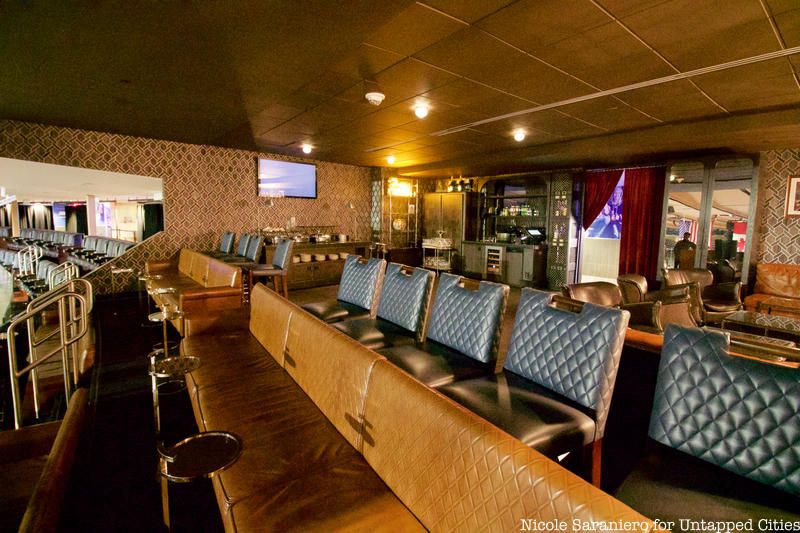
Run by the Tao Group and Madison Square Garden, Suite Sixteen is a members-only VIP lounge only open to a select few. The Suite is decked out with plush leather stadium-style seating and comfy couches with cocktail tables and its own bar and buffet area. The suite is staffed by your personal bartender and catered with food from the Tao Group hospitality restaurants, curated by chefs and partners Ralph Scamardella and Chris Santo.
The luxurious suite was added during the recent renovation and offers great views of the arena. There are four levels of membership you can apply for to gain access.. Prices are not listed. Membership will grant you access to the lounge for two to up to 180 events.
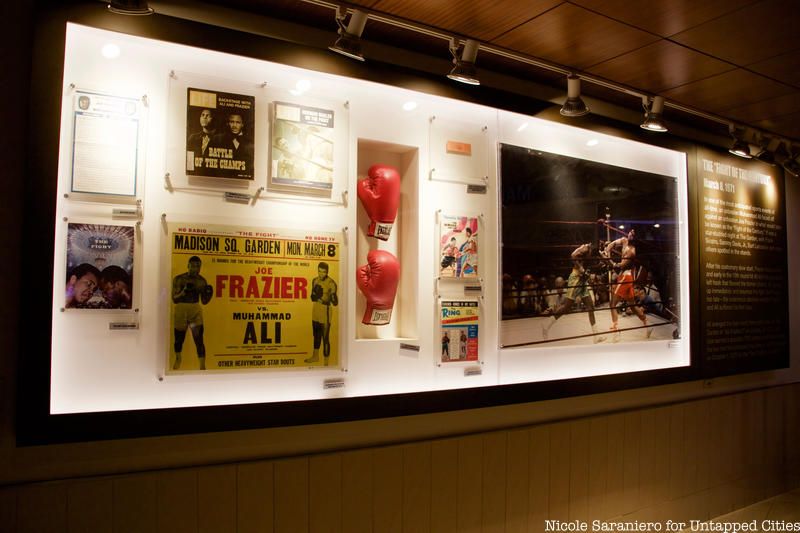
Madison Square Garden has hosted everyone from the Rolling Stones to Pope Francis. Some of the most memorable events are highlighted throughout the corridors of the SAP Concourse in Defining Moments displays. Ringing the ceiling around the concourse is Garden 366, a retrospective look at some of the most momentous events of the Garden’s 130 year history, one moment for every day of the calendar year.
Some of the moments highlighted are “The Fight of the Century” between Joe Frazier and Muhammad Ali, a mass held by Pope Francis’ in 2015, and “The Dunk.” Inside these cases, you’ll find authentic artifacts and ephemera from the events, such as boxing gloves signed by Frazier and Ali, tickets to the mass, and the camera that took the famous photo of 6’3″ Knicks player John Starks’ dunk on Micheal Jordan in the 1993 NBA playoffs.
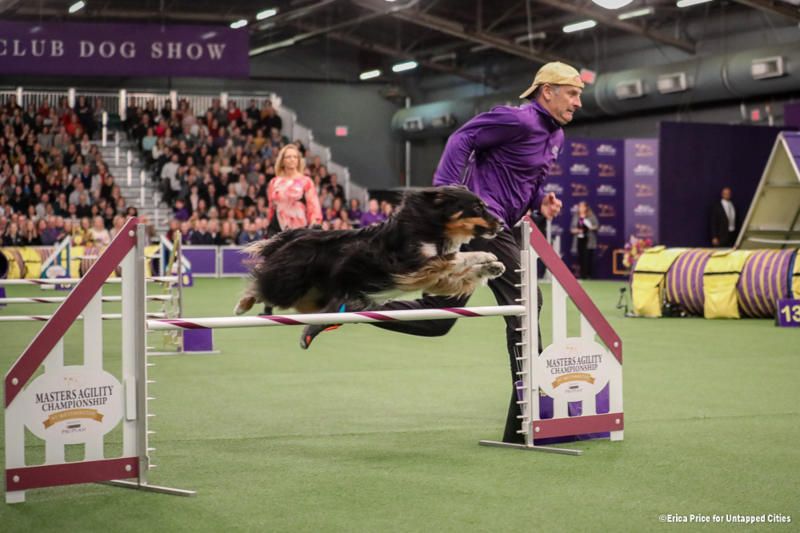
The Westminster Kennel Club Dog Show‘s group and Best in Show competitions were held at the Garden every year from 1877 to 2020, making the Dog Show the longest continuous tenant of the venue. This was broken in 2021, when the Dog Show was moved outside for the first time due to COVID-19. The Dog Show is the second-longest continuously held sporting event in the U.S. behind the Kentucky Derby.
The show began as a competition for gun dogs, such as Pointers and Setters, who were owned by a group of hunters. And the prizes were glamorous — to some: the most prized awards were pearl-handled pistols, The first show drew over 1,200 dogs, taking four days. Proceeds from the fourth day were even donated to the ASPCA, which was founded in 1866. Beginning in 1884, the AKC starting requiring that all dog participants were registered with the AKC and properly recognized for competition.
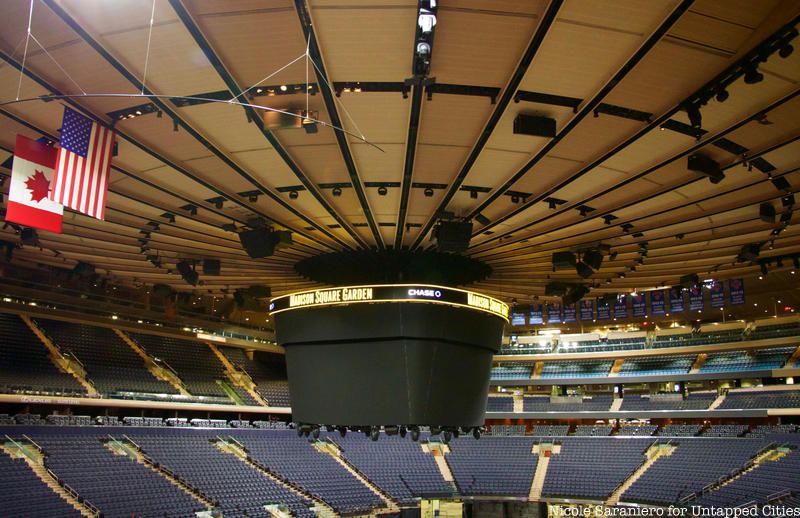
One of the most iconic features of Madison Square Garden is its arena ceiling, the only concave stadium ceiling the world. The reverse dome ceiling was designed by Charles Luckman, the arena’s architect. It is made out of perforated metal and sound absorbent acoustic installation, which helps make the Garden a favorite of many A-list musicians. It was fully restored during the Garden’s recent renovations.
The ceiling which floats about 20,000 spectators is supported by 48 bridge-like steel cables that connect in a tension ring at the center. This column-less structure means every seat in the house has an unobstructed view. Hanging from the middle of the ceiling is the Garden Vision scoreboard, which weights 49,000 pounds and has a seamless wrap-around screen and screens on the bottom as well.
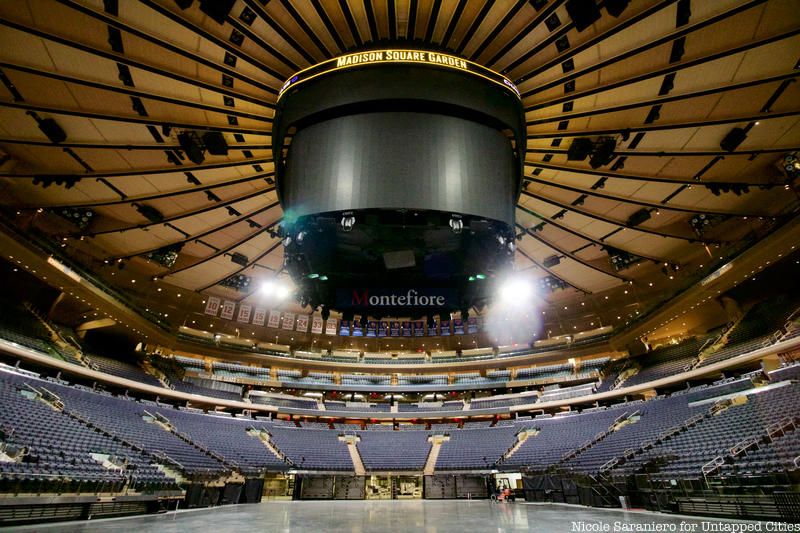
Madison Square Garden has hosted hundreds of concerts, but perhaps one of the most notable was John Lennon‘s last concert appearance in 1974, six years before his death. John Lennon joined Elton John on stage for a surprise guest performance, a particular shock to many fans who had missed seeing Lennon perform in the years prior. In 1972, in Lennon’s last full-length concert appearance, he and Yoko Ono performed two benefit concerts to aid patients at Willowbrook State School mental facility.
Just over two months prior to the 1974 concert, Lennon released “Whatever Gets You Thru the Night,” a single that who be his only #1 hit as a solo act. Elton John played in his session band, providing keys and vocal harmonies. John joked that if the single reached #1, Lennon would come play at one of his shows. Sure enough, it happened, and Lennon performed the hit single, as well as renditions of “Lucy In The Sky With Diamonds” and “I Saw Her Standing There.”
Next, check out The Top 12 Secrets of NYC’s Madison Square
This article was written by Nicole Saraniero and Marc Rich
Subscribe to our newsletter